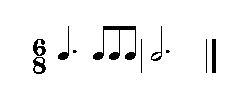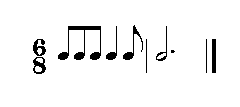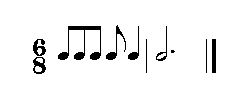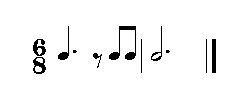Reading Music : Simple and Compound Meters
The types of measures we have studied so far use what is called simple meter. In a simple meter, each beat is divided into equal halves. In the case of a 4/4 meter, each beat is divided into two eighth notes, as we saw earlier.
In compound meters, the beats are divided into three equal parts. We can recognize a compound meter because it uses 6, 9, or 12 for the top number of the bar. Let's look at some examples of the compound meter 6 over 8 (6/8). This meter has two beats; the note value with the value of one beat is the dotted quarter note (crotchet), which can be divided into three eighth notes (quavers).




Visit the Reference Section for more information.
Translated by Dan Román, revised by Sue Talley.
